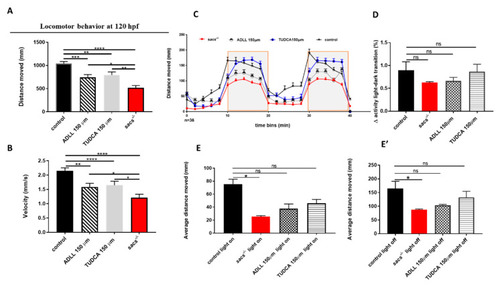Figure 4
- ID
- ZDB-FIG-210902-63
- Publication
- Naef et al., 2021 - Efficient Neuroprotective Rescue of Sacsin-Related Disease Phenotypes in Zebrafish
- Other Figures
- All Figure Page
- Back to All Figure Page
|
Treatment of homozygous sacs−/− mutants with TUDCA and ADLL is able to rescue the locomotor impairment seen in sacs−/− larvae. (A,B) Automated analysis of spontaneous motor activity of sacs−/− after drug treatments (untreated sacs−/− n = 100; sacs−/− mutants treated with ADLL/Tanganil™ n = 150; sacs−/− mutants treated with TUDCA n = 150; controls n = 167) in 4 independent experiments. * p ≤ 0.05, ** p ≤ 0.01, *** p ≤ 0.001, **** p ≤ 0.0001were calculated by the Mann-Whitney test. (C) Swimming pattern of sacs−/− after drug treatments (untreated sacs−/− n = 34; sacs−/− mutants treated with ADLL/Tanganil™ n = 34; sacs−/− mutants treated with TUDCA n = 34; controls n = 34). Each point in the graph represents the mean ± standard error of the mean of the distance moved by zebrafish larvae in 2-min time bins. The shaded parts represent the dark and the unshaded parts the light periods. The total number of embryos used for each group tested was 36. (D) Between-group differences in the average total activity were evaluated by comparing 1 min after and 1 min before light-to-dark and dark-to-light transitions. Values are represented as means ± standard error of the means. (E,E’) The average of the total activity of each group was measured during light on (E) and light off (E’) conditions. * p ≤ 0.05, calculated by Dunnett’s multiple comparisons test. Abbreviations: n, number of evaluated embryos in total; ns, not significant. |
| Fish: | |
|---|---|
| Conditions: | |
| Observed In: | |
| Stage: | Day 5 |

